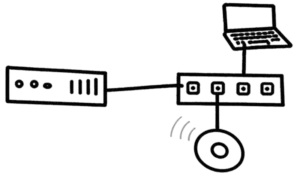
What is a switch?
A switch works like a power strip that supplies multiple devices with power from a single socket. Instead of power, however, the switch distributes data to various devices that share a network socket and ensures that each device receives the data it needs.
How does a switch work?
A network switch has many connections (also called ports). Various devices can be connected to these ports, such as computers, printers or another switch. The switch then ensures that the data sent by a device only reaches the device that actually needs it.
A network switch plays an important role in setting up an efficient and well-organized network. Particularly in large buildings such as offices or schools, the switch helps to distribute the network cleverly without having to lay a separate cable for each device to the central network point.
Network switches for sub-distribution
Sub-distribution means that a single cable is laid to a central point (e.g. a room or a floor) and only there, with the help of a switch, is the network distributed to several devices. This not only saves time, but also costs, as you don't have to lay a separate cable across the building for each device.
Example:
- Central cable: You run a single cable from your router to a room or area where several devices are located (e.g. an office).
- Connection to the switch: In this room you connect the cable to a network switch.
- Distribution to several devices: Several devices (such as computers, printers or telephone systems) can then be connected from the switch.
- These devices then all use the same Internet or network connection without the need for additional cables.
Managed switch and unmanaged switch
An unmanaged switch works as soon as it is connected, without having to be configured. It distributes the data automatically between the connected devices, is easy to operate and is sufficient for many simple networks, such as at home or in small offices.
A managed switch, on the other hand, can be individually configured and monitored. It offers more control over data traffic, makes it possible to define certain settings such as prioritization or virtual networks (VLANs) and is ideal for larger networks where flexibility, security and performance are important.
Difference to a hub
A hub is similar to a switch, but less "intelligent". A hub simply sends the data to all connected devices, even if it is not intended for them. The switch, on the other hand, only sends the data to the right destination. This makes the switch more efficient and faster. Hubs are generally no longer used these days.
Conclusion
A switch is therefore like an intelligent power strip for data: It connects several devices in a network to a single data socket and ensures that each device receives exactly the data it needs.